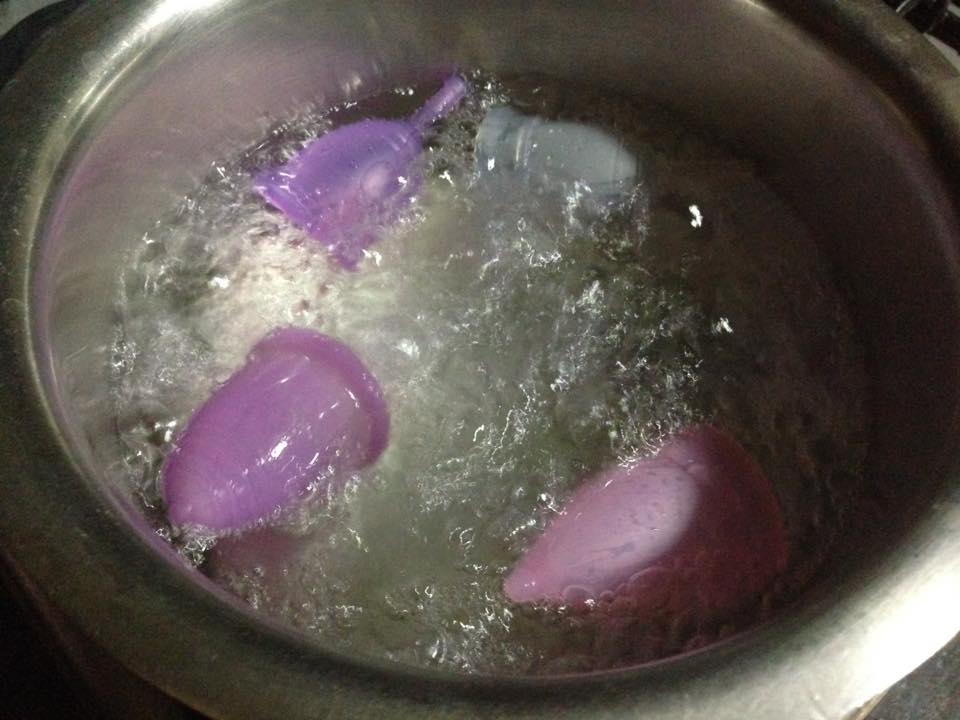How to Clean Your Menstrual Cup
Cleaning the menstrual cups is not as big a task as it seems to be at the beginning. Here are a few steps that we must follow to ensure hygiene and avoid infections.
#01 Sterilising the cup
Is it really needed? Our vagina is not a sterile organ (unlike other organs of our body) and hence we do not need to sterilize the cup after each use. Just cleaning with water or dipping it in hot/boiling water for 5-7 minutes is enough. Once dry, you can store it in the cloth bag that comes with the cup.
However, if you wish to clean it more thoroughly, you can follow the points below:
Boiling over the stove: Boil the cup immersed in water over the stove for 6-8 minutes (2-4 minutes for TPE cups). You can keep a separate steel pan for this purpose. Do not leave it unattended and ensure that there is enough water in the pan throughout. You can also keep the cup inside a whisk to ensure it does not touch the bottom of the pan, in case all water gets evaporated.
Boiling in the microwave: Avoid using the microwave regularly for silicone cups as it can damage the material, however, it is ok to use the microwave for TPE cups. Keep your cup in a microwave (food safe) container or ceramic coffee mug, filled with water, and boil for 3-5 minutes (depending on microwave power). Do not leave it unattended and ensure that there is enough water in the container throughout. Be careful while removing from microwave as the container and cup can be really hot.
- Tip 01: Sterilize the menstrual cup in boiling water with a little salt. This helps to prevent discoloration and increases the cleaning effect.
- Tip 02: Soaking in vinegar water: A little vinegar in water can help to prevent scale deposits and has a natural disinfecting and deodorizing effect. Use vinegar in hot or cold water, with a 3% concentration of vinegar.
- Tip 03: Using sterilizing solution or tablets: These are commonly used to sterilize baby equipment and can be easily found at your local pharmacy or chemist shop. Follow the manufacturer’s guidelines for dilution and soak for the minimum recommended time. Then rinse your menstrual cup thoroughly with clean water.
#02 Cleaning during periods
Every time you remove, empty and re-insert the cup, you can wash with regular or drinking water. Once a day, you can use mild and unscented soap to clean the cup. Avoid using products with oil/essential oils in them, as oil forms a thin layer on the cup which is difficult to remove. Avoid vaginal wash, antiseptics (like Dettol or Savlon) and antiseptic soaps. Always rinse it well with water after using soap as any traces left on the menstrual cup may cause irritation. You can also use probiotic/ natural/cold-pressed soap which can be used to clean your menstrual cup.
Tip 03: Before each insertion, ensure all air holes are clean and free from blood/discharge/soap. You can clean them by:
- folding the cup at the air hole under running water.
- Fill the menstrual cup with water and force the water out of the holes by blocking the entrance of the cup with the palm of your hand.
- you can also use an inter-dental brush (or bristles of a regular toothbrush) or toothpick but avoid using metal pins and needles as they can ruin the texture of your cup.
#03 While traveling
You can carry a small bottle of drinking water to the toilet. If water is not available, you can use toilet paper or coin tissues to wipe the cup. Sometimes it is OK to just empty and re-insert if you don’t have access to water or paper. But don’t make it a habit, and give the cup a good rinse when you get a chance. Make sure no blood is left in the air holes.
#04 Notice Discolouration or Smell?
Discoloration of your menstrual cup with time is normal. To remove color, silicone cups can be kept in direct sunlight (not the TPE cups).
You can also use sodium bicarbonate (suitable for cooking), pour onto a damp cloth or toothbrush, and scrub the cup to clean the staining off, make sure you clean and sterilize the cup after that. Do not soak the cup in this solution, only rubbing is recommended.
To prevent unpleasant odors, the menstrual cup should be removed every 8 to 10 hours. Some women have noticed temporary changes in smell, which is likely due to various proteins in the blood. A menstrual cup may suddenly assume a different smell, although it has been cleaned as usual.
Usually, the odor disappears when you place your sterilized cup in a dry, well-ventilated place for several days. You can also place your menstrual cup a few hours in a glass of denture cleaner, or sterilize with vinegar or saltwater.
Tip 04: Ideally, your menstrual cup should not develop a strong odor. This could be a result of
- a vaginal infection
- leaving the cup in for longer than recommended time or
- boiling the cup in the pan that had traces of food.
Happy cupping.
For more details and tips, watch our videos.




